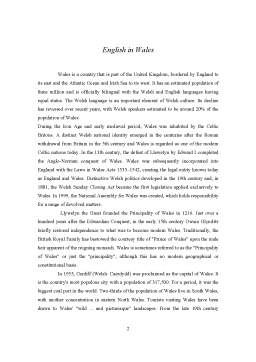Extras din proiect
Wales is a country that is part of the United Kingdom, bordered by England to its east and the Atlantic Ocean and Irish Sea to its west. It has an estimated population of three million and is officially bilingual with the Welsh and English languages having equal status. The Welsh language is an important element of Welsh culture. Its decline has reversed over recent years, with Welsh speakers estimated to be around 20% of the population of Wales.
During the Iron Age and early medieval period, Wales was inhabited by the Celtic Britons. A distinct Welsh national identity emerged in the centuries after the Roman withdrawal from Britain in the 5th century and Wales is regarded as one of the modern Celtic nations today. In the 13th century, the defeat of Llewelyn by Edward I completed the Anglo-Norman conquest of Wales. Wales was subsequently incorporated into England with the Laws in Wales Acts 1535–1542, creating the legal entity known today as England and Wales. Distinctive Welsh politics developed in the 19th century and, in 1881, the Welsh Sunday Closing Act became the first legislation applied exclusively to Wales. In 1999, the National Assembly for Wales was created, which holds responsibility for a range of devolved matters.
Llywelyn the Great founded the Principality of Wales in 1216. Just over a hundred years after the Edwardian Conquest, in the early 15th century Owain Glyndŵr briefly restored independence to what was to become modern Wales. Traditionally, the British Royal Family has bestowed the courtesy title of "Prince of Wales" upon the male heir apparent of the reigning monarch. Wales is sometimes referred to as the "Principality of Wales" or just the "principality", although this has no modern geographical or constitutional basis.
In 1955, Cardiff (Welsh: Caerdydd) was proclaimed as the capital of Wales. It is the country's most populous city with a population of 317,500. For a period, it was the biggest coal port in the world. Two-thirds of the population of Wales live in South Wales, with another concentration in eastern North Wales. Tourists visiting Wales have been drawn to Wales' "wild and picturesque" landscapes. From the late 19th century onwards, Wales acquired its popular image as the "land of song," attributable in part to the revival of the eisteddfod tradition.
National Emblems
The Leek
According to legend, St David advised the Britons on the eve of a battle with the Saxons, to wear leeks in their caps so as to easily distinguish friend from foe. This helped to secure a great victory. Today Welsh people around the world wear leeks on St David's Day. It is also a surviving tradition that soldiers in the Welsh regiments eat a raw leek on St David's Day.
The Daffodil
The Welsh for leek (the original national emblem) is Cenhinen, while the Welsh for daffodil is Cenhinen Pedr. Over the years they became confused until the daffodil was adopted as a second emblem of Wales.
The Harp
The harp is regarded as the national instrument of Wales. By the end of the 18th century, the triple harp - so called because it had three rows of strings - was widely known as the Welsh harp on account of its popularity in Wales. The harp has been used through the ages as an accompaniment to folk-singing and dancing and as a solo instrument. HRH Prince Charles appoints a Welsh Royal Harpist on a scholarship programme annually. Past Royal harpists include Catrin Finch.
The Prince of Wales Feathers
The Crest of three ostrich plumes and the motto "Ich Dien" (I serve) were adopted by Edward the Black Prince at the Battle of Crecy. Edward became Prince of Wales in 1343, and was a popular leader - so much so that thousands of Welshmen joined him to fight in the French wars. In fact, a quarter of Edward's troops were composed of Welsh archers and spearmen. The crest is used today in royal heraldry and the feathers still adorn the badge of the National Rugby Union team of Wales.
The Welsh Flag
The national flag - The Red Dragon (or in Welsh Y Ddraig Goch) - was granted official status in 1959, but the dragon itself has been associated with Wales for centuries. Some say it’s the oldest national flag still in use, and that it was used by King Arthur and other ancient Celtic leaders.
Preview document
Conținut arhivă zip
- English in Wales .doc
















